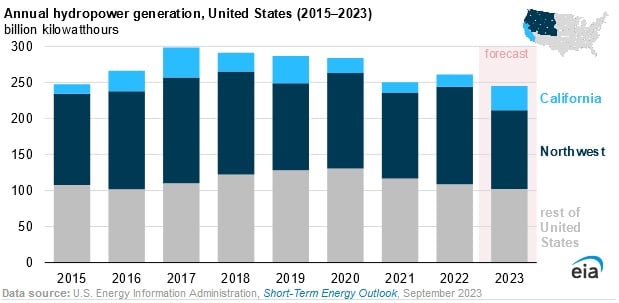U.S. Hydropower Generation Forecast Lowered by Six Percent Due to Weather Events: EIA

The U.S. Energy Information Administration in a report published on Sep. 28 lowered its projection of U.S. hydropower generation by 6 percent for 2023, compared to last year. The reduction in the forecast is attributed to weather outcomes in the U.S. Northwest over spring and summer, which led to curtailed water supply.
U.S. hydropower capacity has increased over the last decade, due to a combination of improvements to existing plants and new projects. Hydropower accounts for around 6 percent of total U.S. electricity generation.
The northwest generates almost 50 percent of U.S. hydropower and experienced above seasonal normal temperatures in May that melted snow swiftly which resulted in a noteworthy loss of water supply. Due to a reduction in water supply, the region produced 24 percent less hydropower in the first six months of 2023, compared to the same period in 2022. The agency projects 19 percent less hydropower production in the Northwest during 2023, compared to 2022.
Higher than expected production in California counterbalances the reduction in hydropower in the Northwest. California generated 94 percent more hydropower in the first six months of 2023, compared to the same period in 2022. The increase in California hydropower production can be attributed to unrivalled winter rainfall filling reservoirs and leaving a deep snowpack across the state’s Sierra Nevada mountains. The agency forecast Californian hydropower generation to be 99 percent higher in 2023, compared to 2022.
According to data from the Drought Monitor, California drought provisions have drastically improved compared to last year. However, parts of the Northwest, specifically around the Columbia River Basin, have had progressively harsh drought conditions since June 2023. This will affect water supply, which in turn could limit hydroelectricity generation.
U.S. hydropower generation for the remainder of 2023 is expected to be impacted by El Nino, because of the weather patterns affecting water supply. El Nino is correlated with wetter than average conditions in the Southwest U.S. and warmer than average temperatures in the Northwest.
EnerKnol Pulses like this one are powered by the EnerKnol Platform—the first comprehensive database for real-time energy policy tracking. Sign up for a free trial below for access to key regulatory data and deep industry insights across the energy spectrum.
ACCESS FREE TRIAL